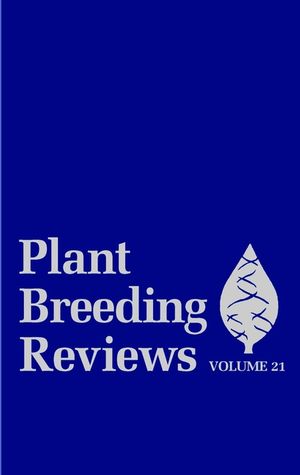Plant Breeding Reviews, Volume 21ISBN: 978-0-471-41847-4
Hardcover
336 pages
October 2001
 This is a Print-on-Demand title. It will be printed specifically to fill your order. Please allow an additional 10-15 days delivery time. The book is not returnable.
|
||||||
Contributors.
1. Dedication: Dirk R. Vuylsteke, Musa Scientistand Humanitarian (Rodomiro Ortiz).
I. Biographical Sketch.
II. Research Achievement.
III. The Man.
2. Epistasis and Plant Breeding (James B. Holland).
I. Introduction.
II. Gene Action and Statistical Effects.
III. Epistasis and Molecular Interactions.
IV. Complex Molecular Interactions Underlie QuantitativePhenotypes (Sometimes).
V. Biometrical Evidence for Epistasis.
VI. Evidence for Epistasis from Plant Evolution Studies.
VII. Molecular Marker Investigations of Epistasis.
VIII. Why Is There More Evidence for Epistasis from QTLExperiments than from Biometrical Studies?
IX. Implications of Epistasis for Plant Breeding.
Literature Cited.
3. Origin, History, and Genetic Improvementof the Snap Pea (Pisum sativum L.) (James R. Myers, James R. Baggett, and Calvin Lamborn).
I. Introduction.
II. Genetics of Snap Peas.
III. Breeding Objectives.
IV. Breeding Methods.
V. Traits of Special Concern.
VI. Molecular Markers and Transformation.
VII. Future Prospects.
Literature Cited.
4. Strawberry Biotechnology (Stan C. Hokanson and John L. Maas).
I. Development of the Modern Strawberry.
II. Genetic Fingerprinting and Gene Tagging.
III. Mapping.
IV. In Vitro Biology, Genetic Transformation,and Gene Cloning.
V. Future Prospects.
Literature Cited.
5. Contributions of DNA Molecular MarkerTechnologies to the Genetics and Breedingof Wheat and Barley (Robert M. D. Koebner, Wayne Powell,and Paolo Donini).
I. Introduction.
II. Molecular Markers in Genetic DiversityStudies in Wheat and Barley.
III. Molecular Markers for Cultivar Identification.
IV. Marker Assisted Selection.
V. Marker-Based Genotyping in Crop Breedingand Genetics.
VI. The Future of Molecular Genotyping in CropBreeding and Genetics.
Literature Cited.
6. Diversity in Landraces of Cereal and Legume Crops (Awegechew Teshome, A. H. D. Brown, and T. Hodgkin).
I. Introduction.
II. Geographic Divergence.
III. Factors Affecting Diversity.
IV. Conclusions.
Literature Cited.
7. Production and Evaluation of Hybrid Soybean (R. G. Palmer, J. Gai, H. Sun, and J. W. Burton).
I. Introduction.
II. Flower Morphology and Pollination.
III. Insect-Mediated Cross-Pollination.
IV. Male Sterility.
V. Male Sterility as a Tool in Plant Breeding.
VI. Heterosis in Soybean.
VII. Discussion and Summary.
Literature Cited.
Subject Index.
Cumulative Subject Index.
Cumulative Contributor Index.
1. Dedication: Dirk R. Vuylsteke, Musa Scientistand Humanitarian (Rodomiro Ortiz).
I. Biographical Sketch.
II. Research Achievement.
III. The Man.
2. Epistasis and Plant Breeding (James B. Holland).
I. Introduction.
II. Gene Action and Statistical Effects.
III. Epistasis and Molecular Interactions.
IV. Complex Molecular Interactions Underlie QuantitativePhenotypes (Sometimes).
V. Biometrical Evidence for Epistasis.
VI. Evidence for Epistasis from Plant Evolution Studies.
VII. Molecular Marker Investigations of Epistasis.
VIII. Why Is There More Evidence for Epistasis from QTLExperiments than from Biometrical Studies?
IX. Implications of Epistasis for Plant Breeding.
Literature Cited.
3. Origin, History, and Genetic Improvementof the Snap Pea (Pisum sativum L.) (James R. Myers, James R. Baggett, and Calvin Lamborn).
I. Introduction.
II. Genetics of Snap Peas.
III. Breeding Objectives.
IV. Breeding Methods.
V. Traits of Special Concern.
VI. Molecular Markers and Transformation.
VII. Future Prospects.
Literature Cited.
4. Strawberry Biotechnology (Stan C. Hokanson and John L. Maas).
I. Development of the Modern Strawberry.
II. Genetic Fingerprinting and Gene Tagging.
III. Mapping.
IV. In Vitro Biology, Genetic Transformation,and Gene Cloning.
V. Future Prospects.
Literature Cited.
5. Contributions of DNA Molecular MarkerTechnologies to the Genetics and Breedingof Wheat and Barley (Robert M. D. Koebner, Wayne Powell,and Paolo Donini).
I. Introduction.
II. Molecular Markers in Genetic DiversityStudies in Wheat and Barley.
III. Molecular Markers for Cultivar Identification.
IV. Marker Assisted Selection.
V. Marker-Based Genotyping in Crop Breedingand Genetics.
VI. The Future of Molecular Genotyping in CropBreeding and Genetics.
Literature Cited.
6. Diversity in Landraces of Cereal and Legume Crops (Awegechew Teshome, A. H. D. Brown, and T. Hodgkin).
I. Introduction.
II. Geographic Divergence.
III. Factors Affecting Diversity.
IV. Conclusions.
Literature Cited.
7. Production and Evaluation of Hybrid Soybean (R. G. Palmer, J. Gai, H. Sun, and J. W. Burton).
I. Introduction.
II. Flower Morphology and Pollination.
III. Insect-Mediated Cross-Pollination.
IV. Male Sterility.
V. Male Sterility as a Tool in Plant Breeding.
VI. Heterosis in Soybean.
VII. Discussion and Summary.
Literature Cited.
Subject Index.
Cumulative Subject Index.
Cumulative Contributor Index.



